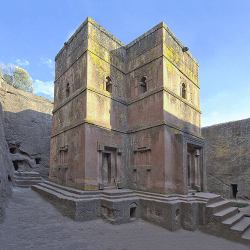UNESCO World Heritage Sites in Italy are:
- Rock Drawings in Valcamonica
- Church and Dominican Convent of Santa Maria delle Grazie with “The Last Supper” by Leonardo da Vinci
- Historic Centre of Rome, the Properties of the Holy See in that City Enjoying Extraterritorial Rights and San Paolo Fuori le Mura
- Historic Centre of Florence
- Piazza del Duomo, Pisa
- Venice and its Lagoon
- Historic Centre of San Gimignano
- The Sassi and the Park of the Rupestrian Churches of Matera
- City of Vicenza and the Palladian Villas of the Veneto
- Crespi d’Adda
- Ferrara, City of the Renaissance, and its Po Delta
- Historic Centre of Naples
- Historic Centre of Siena
- Castel del Monte
- Early Christian Monuments of Ravenna
- Historic Centre of the City of Pienza
- The Trulli of Alberobello
- 18th-Century Royal Palace at Caserta with the Park, the Aqueduct of Vanvitelli, and the San Leucio Complex
- Archaeological Area of Agrigento
- Archaeological Areas of Pompei, Herculaneum and Torre Annunziata
- Botanical Garden (Orto Botanico), Padua
- Cathedral, Torre Civica and Piazza Grande, Modena
- Costiera Amalfitana
- Portovenere, Cinque Terre, and the Islands (Palmaria, Tino and Tinetto)
- Residences of the Royal House of Savoy
- Su Nuraxi di Barumini
- Villa Romana del Casale
- Archaeological Area and the Patriarchal Basilica of Aquileia
- Cilento and Vallo di Diano National Park with the Archeological Sites of Paestum and Velia, and the Certosa di Padula
- Historic Centre of Urbino
- Villa Adriana (Tivoli)
- Assisi, the Basilica of San Francesco and Other Franciscan Sites
- City of Verona
- Isole Eolie (Aeolian Islands)
- Villa d’Este, Tivoli
- Late Baroque Towns of the Val di Noto (South-Eastern Sicily)
- Sacri Monti of Piedmont and Lombardy
- Monte San Giorgio
- Etruscan Necropolises of Cerveteri and Tarquinia
- Val d’Orcia
- Syracuse and the Rocky Necropolis of Pantalica
- Genoa: Le Strade Nuove and the system of the Palazzi dei Rolli
- Ancient and Primeval Beech Forests of the Carpathians and Other Regions of Europe
- Mantua and Sabbioneta
- Rhaetian Railway in the Albula / Bernina Landscapes
- The Dolomites
- Longobards in Italy. Places of the Power (568-774 A.D.)
- Prehistoric Pile Dwellings around the Alps
- Medici Villas and Gardens in Tuscany
- Mount Etna
- Vineyard Landscape of Piedmont: Langhe-Roero and Monferrato
- Arab-Norman Palermo and the Cathedral Churches of Cefalú and Monreale
- Venetian Works of Defence between the 16th and 17th Centuries: Stato da Terra – Western Stato da Mar
- Ivrea, industrial city of the 20th century
- Le Colline del Prosecco di Conegliano e Valdobbiadene
- Padua’s fourteenth-century fresco cycles
- The Great Spa Towns of Europe
- The Porticoes of Bologna
- Evaporitic Karst and Caves of Northern Apennines
> View other UNESCO World Heritage Sites
More on World Heritage Sites
UNESCO (United Nations Educational, Scientific and Cultural Organization) World Heritage Sites comprise 1,199 properties.

World heritage property is a legacy from the past, that people live with today, and pass on to future generations.

The cultural and natural heritage are both irreplaceable sources of knowledge and inspiration.





UNESCO seeks to encourage the identification, protection and preservation of cultural and natural heritage around the world that are considered to be of outstanding value to humanity. This is embodied in an international treaty known as the Convention concerning the Protection of the World Cultural and Natural Heritage, adopted by UNESCO in 1972.
A World Heritage Site is an area or landmark designated by UNESCO for having cultural, historical, scientific or other forms of significance. The sites have legal protection by an international convention.
A World Heritage Site is nominated by their host country and determined by the international committee to be a unique landmark which is geographically and historically identifiable and having a special cultural or physical significance. World Heritage Sites are usually ones with ancient features, historical structures, buildings, cities, deserts, forests, islands, lakes, monuments or mountains.
The site may signify a remarkable accomplishment of people and serve as evidence of intellectual history or a place of unparralled natural beauty.
The sites are intended for practical conservation for posterity, which otherwise would be subject to risk from human or animal trespassing, unmonitored, uncontrolled or unrestricted access, or threat from local administrative negligence. Sites are demarcated by UNESCO as protected zones.
The programme catalogues, names, and conserves sites of outstanding cultural or natural importance.
The work began with the Convention Concerning the Protection of the World’s Cultural and Natural Heritage. The convention was adopted by the General Conference of UNESCO on 16 November 1972. Since then, 195 states have ratified the convention, making it one of the most widely recognised international agreements and a popular cultural programme.









